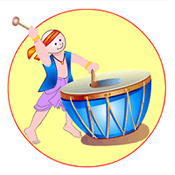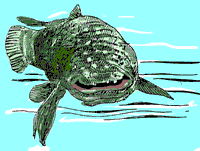
Dimdima
Online Children's Magazine from India

Dimdima
Online Children's Magazine from India
By Rani Iyer

To understand the mystery of this creature, you have to travel back in time, about 150 million years before dinosaurs first appeared on land. The Coelacanth (pronounced SEE-la-canth) is a primitive fish that first appeared about 380 million years ago. The fish is considered primitive, and belongs to the lobe-finned fish (Crossopterygii) family. Its scientific name is Latimeria chalumnae.
After the fossils of this fish were discovered, the Coelacanth was thought to have been extinct for millions of years. In 1932, scientists were stunned to discover it alive and thriving in the Indian Ocean.
In the coast of Madagascar, off South Africa, scientists were thrilled to hear fishermen talk about it! They found that the skin of the fish was too rough and could be used for patching the inner tubes of their bicycles.
Since then, several individual fish have been caught in the Indian Ocean. Because of the rare distinction of being found in fossils and yet alive, scientists refer to them as a 'living fossil.' It is surprising that the fish has never been noticed before. Consider the size. The Coelacanth is about 5 feet (1.5 m) long with a three-lobed tail. Teeth are found only in the front of the mouth, and the jaw is hinged to the skull allowing it to open the mouth widely. The name Coelacanth means, "hollow spine." All the vertebrae of this fish are hollow. The Coelacanth eats other fishes and crustaceans. It gives birth to live young fishes (viviparous). If man doesn't pollute the ocean or disturb it excessively, the Coelacanth will survive well into the next millennium..
Update
Coelocanth has now been reported in territorial waters of Kenya, East Africa, Hong Kong, and Indonesia.
Last updated on :11/10/2003
EXPLORE MORE...
COMMENT ON THIS ARTICLE
Wants to share something related to this article? Please use the form below.
Dimdima is the Sanskrit word for ‘drumbeat’. In olden days, victory in battle was heralded by the beat of drums or any important news to be conveyed to the people used to be accompanied with drumbeats.
Bharatiya Vidya Bhavan
K. M Munshi Marg,
Chowpatty, Mumbai - 400 007
email : editor@dimdima.com
Bharatiya Vidya Bhavan
505, Sane Guruji Marg,
Tardeo, Mumbai - 400 034
email : promo@dimdima.com
Dimdima.com, the Children's Website of Bharatiya Vidya Bhavan launched in 2000 and came out with a Printed version of Dimdima Magazine in 2004. At present the Printed Version have more than 35,000 subscribers from India and Abroad.